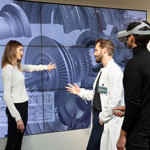
INDUSTRY 4.0
Main player in the new industrial revolution
Digital solutions to improve processes, reduce waste, increase production flexibility and the safety of your industry.
Auditorium, from the Latin audire, "to hear", successor to the Greek amphitheater, a place of shows and music. Today, however, the auditorium can be much more than this: a multipurpose space in which to offer and share new experiences. Thanks to the integration of systems and digital innovation, the auditorium audience is not just limited to listening and watching what happens on stage, but rather is immersed in an experience that deeply involves him and makes him an active participant.
The correct approach to creating or refitting an auditorium must go through the design of the public experience. The construction and structural aspects, such as the viewing angle during sessions, the calculation of the acoustics, the arrangement and layout of the seats, are all vital factors in the creation of an auditorium.
However, in an age where interaction with digital devices is widespread at every level, design must also involve system integrators. Creators of digital environments are thus called upon to make the experience even more engaging, taking advantage of using new technologies and at the same time facilitating all the auditorium management operations.
The technical times in front of an extended audience need to be minimized so that the public can enjoy the experience without hitches, slowdowns or waits. Integration of the control systems on digital dashboards allows you to keep important parameters under control, such as regulating hall lighting, the volume of the audio system, microphones, devices connected to the projection system, the network connection... centralizing these functions in an easy-to-use graphical interface, which can also be activated by mobile devices such as tablets and smartphones, means it's possible to respond quickly and flexibly to all stages of the event, letting the public fully concentrate on what happens on the auditorium stage, without distractions or obstackes.
Sound must be able to reach the whole audience clearly and audibly, and this depends on the architectural structure and acoustics of the room. Delays, echoes, reverberations and rebounds of sound waves must be accurately calculated for an optimal sound experience. Technology is essentially here, offering the possibility of managing and fine-tuning the sound through the latest generation of audio broadcasting systems. Today, bulky speakers of the past are a distant memory, replaced by speakers that can be inserted harmoniously in the architecture of the auditorium, becoming almost invisible.
The auditorium can stimulate active participation through advanced systems for the projection of multimedia contents, which involve the public with storytelling. Today, technology allows us to manage images of the highest quality anywhere that there is a smooth surface: not only the stage, therefore, but also the walls can come to life with graphics, films, and animations that tell a story, stimulating emotional participation.
A modern auditorium can support different projection systems according to the capacity and conformation of the room. Projectors, Video Walls, LED Walls let you expand and intensify the event experience. Videomapping, for example, allows you to project images without distortion even on curved, sloping and irregularly shaped surfaces, while the LED Wall manages video content in high definition without screen size limitations and guarantees optimal viewing even in natural light, removing the need to darken the room. The auditorium can become an immersive environment which arouses wonder and promotes concentration.
The auditorium space can be expanded virtually through the management of videoconference guests or even those who are remotely connected. But not only this: by implementing wi-fi connections for example, you can transform the public from a simple passive viewer to an active collaborator. Using their mobile, tablet or smartphone, they can be involved in opinion polls or challenges inspired by gaming dynamics, or simply be encouraged to give feedback on the event. Instead of just attending, the public participates and produces content.
The integration of digital technology allows participants to offer content, while collecting data on the current experience. The system can be configured to collect feedback from event participants in the auditorium, thus recording data for later reporting. Theis can be useful to improve the next experience, in turn increasing the quality of the service.
The modern auditorium can be equipped with digital audio-video recording systems that allow you to record the event. Shooting can be managed from a control room using simple digital interfaces, or with automatic direction tools. Motion tracking sensors are able to detect speakers' movements on stage, automatically framing them when they are talking. Digital recordings can be shared through the company intranet or directly on the internet. The event thus becomes an exportable and storable content, thereby increasing the value of the event.
As we have seen, the transformation of the auditorium into the Digital Environment multiplies its possibilities of use: conferences, workshops, shows, company meetings, conventions ... It trannsforms from a simple listening place to an active laboratory where memorable collective experiences are made.

Digital solutions to improve processes, reduce waste, increase production flexibility and the safety of your industry.
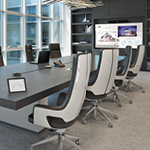
We design Meeting Rooms that integrate AVC hardware, software and automation solutions to physical environments, dedicated to sharing, collaboration and comparison.
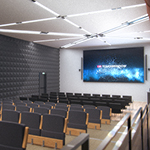
Capture audience attention and engage viewers with impactful visualization systems and integrated AVL architectures.
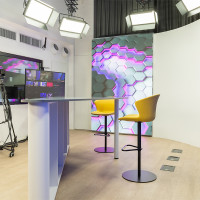
A new technological setup to meet the communication needs of the Region.
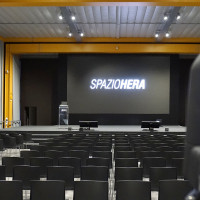
Hera S.p.A. carried out an impressive redevelopment work within the ex gas works area of the city of Bologna. The building has become a space used for events for which we were entrusted with the task of designing and setting up a complete and independent visualization and control system.
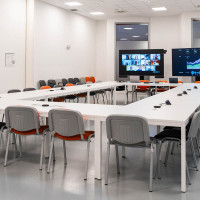
Touchwindow creates a turnkey installation at the DAMA Technopole in Bologna, featuring audio-video solutions, automation, and reconfigurable spaces.